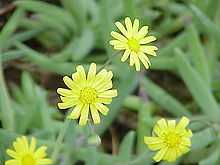Othonna
| Othonna | |
|---|---|
 | |
| Othonna capensis | |
| Scientific classification | |
| Kingdom: | Plantae |
| (unranked): | Angiosperms |
| (unranked): | Eudicots |
| (unranked): | Asterids |
| Order: | Asterales |
| Family: | Asteraceae |
| Tribe: | Senecioneae |
| Genus: | Othonna L. (1753) |
| Type species | |
| Othonna coronopifolia L. | |
| Species | |
|
See text | |
| Synonyms | |
|
Doria Thunb. | |
Othonna is a genus of evergreen or deciduous geophytes, dwarf succulents or shrubs belonging to the sunflower family Asteraceae. The genus includes more than 100 species concentrated in the Western Cape of South Africa and southern Namibia. A few species occur in summer rainfall parts of southern Africa. The genus is closely allied to Senecio and can be distinguished principally by details of the involucre. Taxonomically they are in need of a modern revision.
The form or habit of othonnas is very diverse and in this lies much of their appeal to collectors of winter growing succulent plants. The various species may be pachycauls with elongate but proportionately swollen stems, caudiciform caudiciforms or dwarf and compact succulents with short branches. A highly distinctive group is made up tuberous geophytes with subterranean rootstocks and deciduous stems or leaves. Other species are orthodox shrubs.
Leaf diversity is also notable in this genus. A few species possess highly succulent leaves (e.g., O. capensis, O. sedifolia) but most have bifacial leaves that are only slightly succulent. Size and shape is variable, with most species having leaves in the 1-10 cm long range, common shapes being elliptic, lanceolate, oblanceolate or spathulate. The leaf blades may be intricately divided (O. abrotanifolia) or lobed (O. cakilaefolia), amplexicaul or distinctly undulate. Often the leaves are sessile and the lamina is glaucous; leaf margins are entire to coarsely toothed. Some species are dimorphic in that the acaulescent juvenile leaves are very different from the adult leaves that are produced on the flowering stems.
With few exceptions the flowers of othonnas fit the stereotypical "DYC" ("Damned Yellow Composite", a tongue-in-cheek phrase used for a variety of composites) designation. A simple or branched inflorescence gives rise to daisy-like flower heads. The exceptions are a handful of attractive purple-flowered species that are deciduous geophytes. Most if not all species are self-incompatible. The seeds are often proportionately heavy and probably do not travel far from the parent plant without the assistance of brisk winds. In at least some cases the seeds exude a sticky substance when wetted and thus affix themselves to the soil surface, aiding in the establishment of seedlings.
Selected species
- Othonna arminiana
- Othonna cacalioides
- Othonna capensis
- Othonna cineraria[2]
- Senecio cineraria
- Cineraria maritima
- Jacobaea maritima
- Othonna clavifolia
- Othonna euphorbioides
- Othonna furcata
- Othonna geifolia L. [3]
- Cineraria geifolia (L.) L.
- Othonna coronopifolia L.
- Othonna hederifolia
- Othonna herrei
- Othonna lepidocaulis
- Othonna retrofracta
- Othonna palustris[4]
- Senecio congestus
- Tephroseris palustris
- Othonna wrinkleana
References
- ↑ "Othonna". Index Nominum Genericorum. International Association for Plant Taxonomy. 1753. Retrieved 2008-05-22.
- ↑ 2.0 2.1 Germplasm Resources Information Network (GRIN) (1996-09-17). "Genus: Othonna L.". Taxonomy for Plants. USDA, ARS, National Genetic Resources Program, National Germplasm Resources Laboratory, Beltsville, Maryland. Retrieved 2008-05-22.
- ↑ Tropicos. "Cineraria geifolia (L.) L.". Missouri Botanical Garden. Retrieved 2008-04-03.
- ↑ Flora of North America. "Flora of North America Tephroseris palustris (Linnaeus)". Retrieved 2008-03-22.
External links
- Othonna 1998-2004 Philippe Faucon. Retrieved on February 5, 2007.
- African succulents 2003 African Succulents. Retrieved on February 5, 2007.